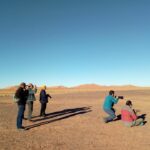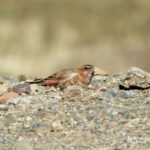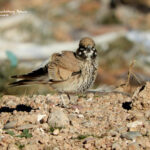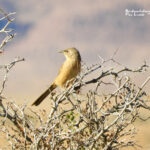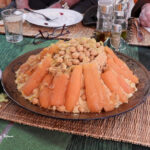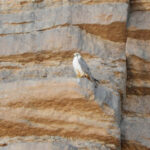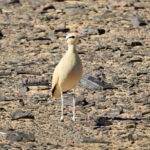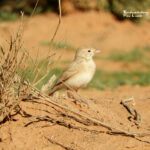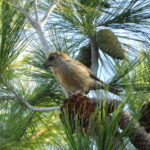Birdwatching and wildlife tours in Spain
Birding trip report Morocco
We hope this birding trip report to Morocco describes the beauty of the landscape as well as the diversity of the birds seen during our Atlas Mountains and Sahara desert trip.
Day 1: 30th November. Marrakech (Birding trip report Morocco)
Carles, Jenny and Pau arrived the day before to Marrakech. During breakfast, Rod arrives and the four of them go for a walk around the city. Shortly after leaving the hotel they see the first Common Bulbul singing in a garden. Just in front of them, in an old mill, Pau spot a small group of House Buntings. After that, the group continues walking to the garden of El Hartí where spend the morning watching birds until the arrival of Chris.
After lunch, Hamid the local guide picks them up to visit the city centre, the medina and the Bahia Palace. Finally, a visit to the bustling Jemaa El Fna, a must-see in Marrakech. The square is full of vendors of spices and leather goods, snake charmers, Barbary macaque to take pictures with and countless places to eat. During the stroll, they observe different species of birds, among them White Storks, Little Swifts and a Common Sparrowhawk.
At dinner time, the six members of the group join, and Pau brief them about the plan for the next day.
Day 2: December 1st. Marrakech-High Atlas (Wildlife trip report to Morocco)
At 9 o’clock in the morning the group leaves Marrakech towards the beautiful mountains of the High Atlas. The first stop is excellent for birds. As soon as they arrive, a small group of Maghreb Magpies show up. This species was split as a different species from the Common Magpie during this year, 2018. Not far from the Magpies, they find a beautiful Moussier’s Redstart, undoubtedly one of the most beautiful birds in all of Morocco. The search for birds continues in the surroundings and soon John find a Southern Grey Shrike of the subspecies elegans. A different subspecies of the Great Grey Shrike that is found in UK. In a nearby cultivated fields, the group locates a group of Barbary Partridges, and at the top of a mound a Little Owl stands out.
The party continues the trip to the High Atlas stopping at the Oukaimeden mountain pass. Along the way, children sell fruits of the strawberry trees in small stands along the road. In a short stop to take landscape pictures, a pair of Bonelli’s Eagle fly over them just few meters away. Superb! Once Hamid drives them to the mountain pass (2600 m asl), is time for having lunch: Moroccan salad and chicken tajin. Now with the bellies full, everyone is ready to look for the specialities of the Atlas.
Oukaimeden pass
In the nearby meadows, a large flock of Common Chaffinch and Rock Sparrow are seen. After an hour of unsuccessful search of the Crimson-winged Finch, they set off to try their luck in another area. Suddenly, a small group of Crimson-winged Finch shows up and lands few meters away from them. That’s a treat for photographers!!! Finally, the last stop of the day is in a meadow where they see the beautiful Atlas Horned Lark and Black Wheatear.
As they have seen all the targets and there is still light, the group decides to make a last stop for woodpeckers. The stop is well worth it as they find the endemic Levaillant’s Green Woodpecker, Great Spotted Woodpecker and the African Blue Tit. Happy with the sightings, the group goes to the lodge; beautiful stone cabins surrounded by cedars and junipers in the Atlas Mountains. The night is chilly so the staff kindly light the fire in the cabins, making our stay even more pleasant.
Day 3: September 2nd. High Atlas-Boumalne du Dades (Birding trip report to Morocco)
Today is basically a transfer from the mountains to the semi-desert of Boumalne du Dades, in total 350 km. The pace of the trip is slow but steady. Few weeks ago, there were severe floods that damaged the main road which crosses the Atlas. Some stops are made along the way to stretch the legs and to see the scarce Magreb Wheatear. The landscape is spectacular with massive snow-capped mountains and fertile valleys where people still plough the fields with donkeys and women wash clothes in the rivers.
After few hours, the van drive through the Moroccan “Hollywood” Ouarzazate, where films as popular as Lawrence of Arabia, Gladiator or The Mummy have been filmed. After fer hours, Hamid drives the minibus through the city of roses, famous for the cultivation of this flower. Today last stop is to see the White-crowned Wheatear. All in all, a long road journey that is necessary in order to visit very interesting and diverse birding areas in Morocco.
Day 4: September 3rd. Boumalne du Dades (Wildlife trip report to Morocco)
After breakfast, the party visit the famous Tagdilt track. Without doubt, this is one of the top areas for birding in Southern Morocco. It takes them only 10 minutes to get there from the hotel in Boumalne du Dades. This track attracts numerous bird species, due to the presence of a nearby landfill. As soon as they arrive, a Long-legged Buzzard flies by in front of them.
Walking along the track, Brahim spots a beautiful male Red-rumped Wheatear, which continually sings its melodic song. The group checks in detail every bird they see and soon find the pretty Thick-billed Lark, a species difficult to find. In addition, the party also enjoys numerous juveniles as well as adults of Temmick’s Larks. What a beautiful bird with its little horns!
The group get into the van and Hamid drives for a couple of kilometres until they bump into a small group of Trumpeter Finches perched on the wires of a fence. At the same time, a beautiful Hoopoe Lark is heard, so the group sets out to look for it in the surrounding fields. They locate up to four different birds, and everyone is impressed by the display of this stunning bird. After that, Hamid take the group to an area to have the picnic. Everyone enjoys the sandwiches of Moroccan omelette while two White-crowned Wheatears perch just few meters away.
On of the favourites: Pharaoh Eagle Owl
About around 1:30 p.m., the party sets off to explore a nearby gorge where they find a small group of Desert Larks. However, the main reason to go there, is to try to locate the Pharaoh Eagle Owl. After looking for it in different areas, Brahim finally find a beautiful bird hiding in a crevice. There is no better way to finish the day than watching this gorgeous owl! As all the targets have been seen, the group decides to return to the hotel a little earlier and have free time the rest of the day. Later, Carles and David go for a walk around the Riat and they find a Laughing Dove.
Day 5: September 4th. Boumalne du Dades-Merzouga (Birding trip report to Morocco)
After breakfast, the group sets off towards Merzouga. This city is the gate to the Sahara. The first stop of the day is in the popular and touristic gorge of Todra. However, this is mainly a stop to enjoy the impressive walls, to buy some souvenirs and to take some photographs of the old towns built by a mixture of mud and straw. After this, the journey continues for one hour until they get to the restaurant to have lunch.
One hour later, it is time for a birding stop. As soon as the group get off the minibus, a Fulvous Babbler is spotted. Where there is one there is more! This beautiful bird is always found in family groups. After that, everyone starts the search of the “mouse”, or better named the Scrub Warbler. It eludes the group by flying from bush to bush, until finally they get it. Speaking of mice, Carles locates a Fat Sand Rat, a common rodent in desert areas. In addition, other species are seen such as Lesser-short toed Lark and gorgeous Bar-tailed Larks, which stand out for their pale coloration. Finally, the journey continues to the hotel. From the terrace of the rooms, there are spectacular views of the desert dunes.
Day 6: September 5th. Birding in the Sahara Desert
Today will be a great day of bird watching in the Sahara Desert. After breakfast, the group meet the drivers and split in the two 4×4 vehicles. The first species they watch is the Brown-necked Raven, which stands out for its brownish colour around the neck, smaller wingspan and bill size than the Common Raven. Their next stop is in a nomad house where the group enjoys superb views of Dessert Sparrow and a Hoopoe Lark. Nomads put out every morning some food and water for the birds. This allows very close observations of these stunning birds. While the group enjoys the green tea generously offered by the nomads, a group of 30 Spotted Sandgrouses fly over the dunes. That’s a good start of the day!
Later, the group visits an area with a little more vegetation where have very good sightings of a Desert Warbler. Furthermore, they see between the bushes a cracking male of Tristram’s Warbler. This bird is much easier found in winter as they spend the cold period in the desert. On the way to the next point, Pau find a female Desert Wheatear and a stunning Cream-coloured Courser. The luck is on their side, as in winter it is a difficult time to find the Courser which tends to move to the South.
Looking for warblers and other targets in the Sahara Desert
At lunchtime, they have a tasty Berber couscous and take the opportunity to buy fossils in the family shop of their local guide. Courtesy of Brahim. During the afternoon, the group set out to look for the only species that remains to be seen, the Lanner Falcon. The sun is strong and the area they explore is facing the sun. While part of the group scans the sky looking for the Falcons, others enjoy the butterflies. There are many interesting species to watch, but the most numerous is the Painted Lady. It has recently been published in a paper that this species is the longest continuously migrating butterfly ever recorded, even more than the Monarch.
The group decides to try their luck with the Lanner Falcon in another area. As they scan the wall, a Red Fox pops up its head from a cave, but no sight of the Falcon. The group is divided to cover the whole area and can only watch the Lanner Falcon for few seconds and far away. Finally, when they were heading back to the vehicles, a Lanner Falcon perched on the wall is spotted by Brahim. A few minutes later, another bird arrives and perches few meters away from the other bird. Happy for finding the bird, the group heads back to the hotel. A wonderful day in the desert!
Day 7: September 6th. Merzouga-Ouarzazate (Wildlife trip report to Morocco)
Today it will start the journey back to Marrakech. During the morning the van crosses the Anti-Atlas mountain range where the Acacias trees dominate the landscape. They make a short stop in this area and find a pair of Tristram’s Warblers, which hide quickly in the thick trees. Ten minutes later, the van is back on the road until lunchtime. The stop is in a restaurant with fabulous views to an oasis. Here small groups of Laughing doves and a colourful Plain Tiger Butterfly are seen.
After an hour’s drive, Hamid stops at the Dadès River, where they find the Moroccan subspecies of White Wagtail and a Cetti’s Warbler among other birds. The last stop before arriving at the hotel is in the reservoir of El Mansour where they see numerous Ruddy Shelducks, Ducks, White Storks and Maghreb Lark, which is considered by some authors a subspecies of the Crested Lark.
Day 8: September 7th. Ouarzazate-Atlas Mountains (Birding in Morocco)
Today’s route runs through the pass of Tizi n’Tichka (2260 m asl) offering spectacular views. One hour later, a stop is made to see a female Blue-rock Thrush perched on the roof of a farm. In the same area, they find a beautiful male of a Moussier’s Redstart and Thekla Larks. The journey continues with a stop for coffee and another to have lunch on a terrace with stunning views of the Atlas Mountains. Before getting to the hotel, a short stroll is taken through some wheat fields. Here they find six Barbary Partridges, Linnets, Corn Bunting and a Long-legged Buzzard.
Day 9: September 8th. Birding in the Atlas-Marrakech
After breakfast, the group go for a walk through the wooded area in the hotel, finding different Common crossbills. It is very likely that this subspecies of Atlas Crossbill will be soon split and therefore be a different species than the Common Crossbill that can be observed in UK. In addition, they find Cirl Bunting, Coal and African Blue Tit and the two subspecies of Chaffinches, the nominal one, and the africana one which is exclusive of North Africa.
Around 11:30 a.m., they are transferred to the airport in Marrakech. Sadly, the birding trip to Morocco comes to an end. All have enjoyed spectacular scenery, birds and a wonderful culture and will certainly go back to Morocco.
Please, do not forget to subscribe to our newsletter, so you will be informed about our international trips!
A completed check-list can be seen and download from here. The March 2020 trip report is available here.
For more information regarding our next bird watching trip to Morocco, please visit our tour calendar.
